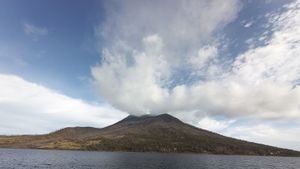
JAKARTA - After discovering a planet similar to Earth, NASA is now announcing their latest discovery. NASA's Hubble Space Telescope discovered a galaxy called the 'Godzilla Galaxy' because of its size.
Godzilla Galaxy has a size 2.5 times larger than the galaxy we inhabit, the Milky Way. In addition, the number of stars in the galaxy is 10 times more than in the Milky Way galaxy.
Quoted from CNN, Friday, January 10, 2020, the Godzilla Galaxy is also referred to as the 'Rubin Galaxy'. Taken from the last name of an astronomer named Vera Rubin who also studied the galaxy. This was conveyed by University of Louisville astronomer Benne Holwerda, who observed Godzilla Galaxy using Hubble.
"My research is largely inspired by Vera Rubin's discovery in the 1980s about the size of this galaxy," said Benne Holwerda.
Holwerda also added that Rubin measured the rotation of galaxies, providing evidence of dark matter. But Holwerda also sees Rubin as missing some of the possible classifications.
Now Holwerda and his team are working to answer that question by analyzing large globular clusters in galaxies, hoping to provide some evidence regarding the galaxy's giant size. The research is ongoing based on images captured by NASA's Hubble Space Telescope.
And the Hubble Time Allocation committee agreed! This is the resulting mosaic plan for the observations. Hubble Wide Field Camera 3 took 4 pictures, in 3 colors (red, green, blue) of a corner of this galaxy with the Advanced Camera for Surveys taking data in parallel. (12 / N) pic.twitter.com/wu5DE6Je9v
- BenneHolwerda (@BenneHolwerda) January 5, 2020
Described as a "gentle giant" by NASA, the Godzilla Galaxy located in the constellation Perseus, has been "sitting still" for billions of years. Possibility of pulling hydrogen from the filament structure of intergalactic space.
The new observations are part of a study to determine how galaxies grow to such an extent. Holwerda presented his data at the winter meeting of the American Astronomical Society in Honolulu, Hawaii.
The Godzilla Galaxy is fairly isolated in space and no galaxies nearby threaten to crash into it or disrupt its spiral disk. It is not clear whether the galaxy eats other smaller galaxies throughout its life or is slowly adding to the gas needed to form new stars.
Since several large galaxies are believed to eat smaller galaxies, one of them is the Milky Way. Holwerda's team is now counting globular clusters in galactic circles to determine whether they captured smaller galaxies over billions of years.
The English, Chinese, Japanese, Arabic, and French versions are automatically generated by the AI. So there may still be inaccuracies in translating, please always see Indonesian as our main language. (system supported by DigitalSiber.id)







